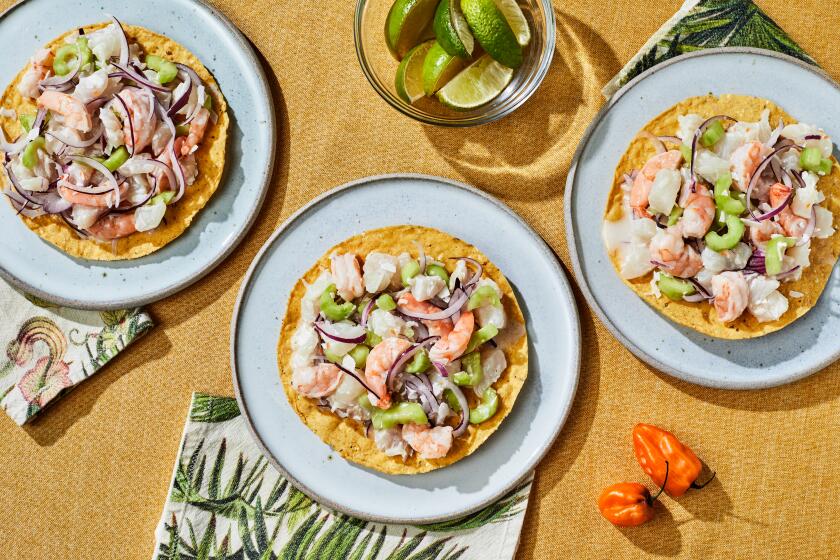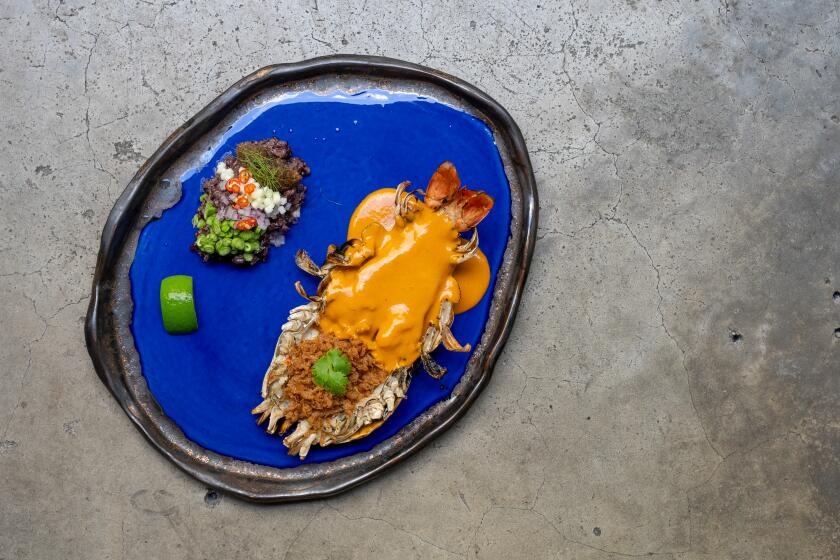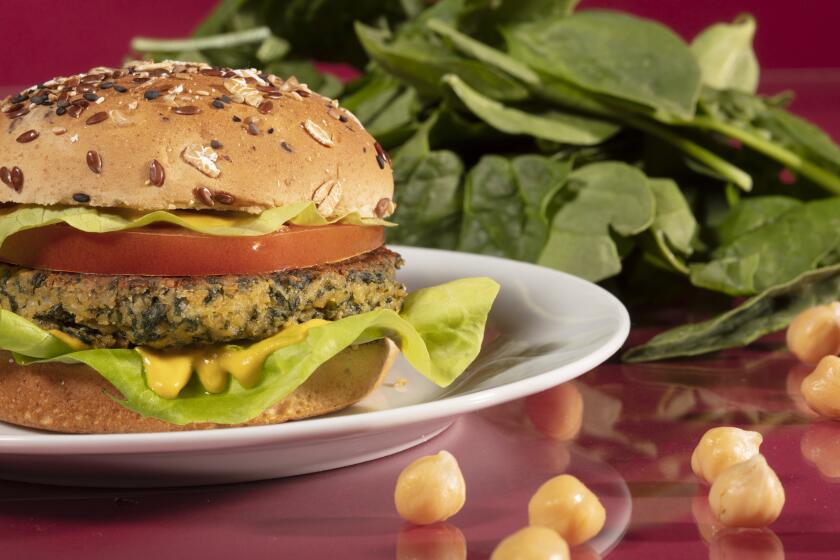Pan-bagnat
Franklin Canyon Park, a sprawling wilderness in the Santa Monica Mountains high over Beverly Hills, is one of L.A.’s best-kept secrets -- a place to hike, to read in the shade, to relax -- a place, perchance, to picnic.
A Mercedes SUV pulls up at road’s end next to an open field framed by lazy sycamores and California live oaks. Out jumps Alain Giraud, L.A.’s leading French chef (and until recently the chef at Bastide), followed by his wife, Catherine. They start unloading, lifting tables, coolers, ice buckets, cartons of plates and silverware over the fence. Baskets of food, piles of table linens, throw pillows, bunches of sunflowers and lavender. Hats, more tables, long baguettes, more baskets of food and a couple of big canvas folding chairs.
“Pour les grand-meres!” says Catherine -- for the grandmothers! “We never travel light.” No, indeed -- at least not when they picnic. For picnicking is something like a religion to the Giraud family.
Not surprisingly, 45-year-old Alain Giraud has very particular ideas about the way a picnic should be. The food must be set up on tables, as a buffet, and then to eat it, you must sit on blankets on the grass. “It’s a hybrid,” he says, “a picnic-buffet. It’s to be outside and be in a place where the kids can run and play and bring the dog.” In the Girauds’ case, that would be Olivia, a bouncy English sheepdog. If it weren’t for the headband keeping Giraud’s thick, shaggy, prematurely silver hair out of his eyes, they’d look suspiciously similar.
And the food? “The essence of the picnic is to be simple,” Giraud philosophizes. “I think a good cheese is important. Good sandwich, and voila. Good company, a good day, a good river.” Well, eighty-six the river. “You’re outside, you’re cool, you’re having some food and boom -- where’s the foie gras?”
In the end, it’s that “where’s the foie gras?” moment that trumps simplicity.
Giraud has put together this particular picnic in honor of Bastille Day, the 14th of July. If it seems he has gone over the top with his six-course menu, believe it or not, to him this is simple. Each component is brilliant picnic food. Marinated Cavaillon melon balls served in their rind. A sandwich that’s like a nicoise salad in a roll and that actually improves by sitting overnight. Tomato-glazed veal paupiettes that are marvelous served cold. A tart that’s gorgeous yet sturdy enough to transport.
Preparations started the morning before, when Giraud shopped for food at the Santa Monica Farmers’ Market, filling his baskets with baby fennel, artichokes, radishes, melons, zucchini, tomatoes, goat cheese from Redwood Farm.
As the rest of the family finishes lunch in the garden of the Girauds’ Pico-Fairfax area home -- a 1920s Spanish house -- Giraud goes to work in the kitchen. He’s wearing baggy shorts; his feet are bare.
Catherine comes inside, a worried look on her face, holding a plastic container.
“Alain, I thought this was potato puree,” she says in French, “and I put it in the microwave.”
Alain’s eyes widen, and he looks as though he might explode. “My frangipane!” he cries, taking it and peering inside. “How long did you zap it?”
“I don’t know -- not too long.”
He had prepared it the night before so he’d have it ready to use in the fig tart. After a stream of invective to which Catherine seems immune, Alain calms down. “No problem,” he says, “I’ll do it again.” Catherine slinks back outside. Alain continues examining the frangipane. Finally, he shrugs and turns his attention to the holiday at hand.
In France, he tells me, Bastille Day is not exactly a picnic op. “They just wheel a bar into the square,” he says. “Every village has a portable bar. And they start drinking. It’s not related to food. Zero. Nothing.”
OK, what happened on Bastille Day? “They attacked the Bastille. And they cut a lot of heads. So I thought alouettes sans tete. It’s a traditional Provencal dish, but it’s also a visual joke: veal paupiettes stuffed with sausage and mushrooms; they look a bit like small birds, but without heads.
“When I was a kid, I was all the time intrigued,” he explains. “Is it a bird? It doesn’t have a head?” Though he’s never made the dish before, it occurred to him that it would be a fun thing to serve on Bastille Day. “It’s simmered in vin blanc,” he says, “but we’ll use Champagne. And tomato. And of course we’ll have to taste the Champagne.”
But first, he prepares the melons, which he bought from Weiser Family Farms, best-known for its fingerling potatoes. The Cavaillons, which are treasured in France for their sweet, cantaloupe-colored flesh, are each about the size of a grapefruit, and perfectly ripe; at $1 apiece, they’re also a bargain.
Traditionally they’re served cut in half, the depression filled with either Port or some version of Muscat, a sweet white aperitif or dessert wine. Giraud uses a melon baller to scoop out the flesh, then he marinates the balls in Muscat de St. Jean de Minervois -- pouring from a bottle he carried from France on his last visit. He then replaces the balls back in the melons. “Basically,” says Giraud, “that’s how you have alcohol at the picnic.” For the kids, he sprinkles the melon balls only with sugar. He wraps them in plastic film and stashes them in the fridge.
Then the paupiettes. He sautes shallots and diced criminis in a cast-iron skillet (“the best thing made in America”), then adds garlic and parsley. After it cools, he scrapes raw sausage into a bowl, adds the mushrooms and some thyme.
He pulls out his industrial-sized roll of plastic film -- Giraud is a real plastic film fan. He places a scaloppine between two sheets of it and pounds the veal thin using the bottom of a heavy pot. After he works his way through them, he’s ready for some help. He spoons some sausage filling onto a scaloppine, folds both sides in, then rolls it up. Next he ties it up, using a tricky chef knot. Can I handle that? I think so. Amazing how perfectionistic a chef can be about, well, picnic food.
Same with the construction of the pan-bagnats. These are juicy sandwiches you make ahead of time, then wrap tightly in plastic so the juices permeate the bread -- pan-bagnat means pain mouille -- “soaked bread” in Nicois dialect. Giraud remembers eating these growing up. “The trucks in St. Tropez by the beach sell pan-bagnats,” he says. “It’s very typical of the south.” For the bread, Giraud settled on focaccia rolls from Il Fornaio. “They’re soft,” he says, pinching them lightly between his fingers, “but not too soft.”
Meanwhile, the paupiettes are simmering. After browning them, he deglazed the pan with the Champagne, then added strained tomatoes. The chef takes a moment to ponder where he’ll set up his sandwich assembly line, then clears a spot. He gathers the pan-bagnat ingredients.
For some reason, he trusts me to slice the rolls in half, but he can’t help stealing a glance to see whether I’m doing it correctly. This is just a chef being a chef. Giraud, in fact, enjoys the reputation of being a chef whom cooks love to work with. While I slice, he carves an artichoke down to the crown, which he slices paper-thin on a plastic mandoline.
He makes a charming little salad of the shaved artichokes and fennel, dressed with lemon juice, fleur de sel and black pepper. Shaved spring onions and radishes make another little salad. Then the quail eggs go in to boil (it’s fine to use regular eggs).
Giraud slices ripe tomatoes. “I don’t want to buy the heirlooms,” he says, “they don’t have too much juice.” Everything’s ready for assembly: tapenade from Trader Joe’s, $14 Italian tuna packed in olive oil. Tapenade is spread on the tops of the buns; his best olive oil gets drizzled on the bottom. He layers tomato slices, then sprinkles fleur de sel, “for the juice.” Then the artichoke salad, tuna, anchovies, radish-onion salad, quail egg halves and a drizzle of oil from the tuna. He places the top of the roll on top. “Schmuga!” shouts Giraud, pushing it down.
Wrapping these is an art in itself; Giraud demonstrates. The sandwich goes in the center of a length of plastic film. Roll the thing up -- tightly. Holding by the excess plastic on each side, twirl tightly until the ends are like ropes. Wrap the ends around either side, and then wrap tightly in aluminum foil.
The fig tart, of course, is still at issue. Giraud makes a new frangipane, beating together butter, sugar and eggs, then adding almond meal and flour. He thinks he can rescue some of the microwaved first effort. He spoons a little into the mixer bowl, peers in, tastes. “If I were the pastry chef, I’d be dead!”
But no harm is done. After wrestling with a very soft dough for the crust (the big roll of plastic film again saves the day, since he can roll it out between large sheets) he halves the figs, then decides it’ll be prettier if he quarters them. “I’m king of the figs,” he says.
Your picnic is served
Next day, at the picnic, the spread is magnificent, very Provencal. The food is arranged on a table covered with a dappled green cloth; the cheese is displayed on the perfect straw tray. And no paper plates for this family: A meal this wonderful deserves ceramic dishes in shades of mustard and olive green and stainless flatware rolled up in cloth napkins.
The Girauds’ two children -- 13-year-old Camille and Antonin, who will be 12 in a few days -- and friends excitedly help themselves.
Alain uses an outsized pocket knife to carve the saucisson Catherine recently smuggled from Lyon. Everyone loves the Cavaillons, even as we wonder, for an uncomfortable minute, whether the kids got the ones without the alcohol. Alain surreptitiously fills our glasses with more of the Muscat. The alouettes are a smash, the pan-bagnat juicy and wonderful. The kids drink sparkling pink lemonade; we drink rose -- who’s to know? And anyway, who can appreciate cheese without wine?
Then Giraud slices the beautiful fig tart. We pick it up and eat it with our hands. The fabulous frangipane melts into the almondy crust. The figs -- the first black missions of the season -- are bursting with flavor. It’s a spectacular finish: Giraud really is the king of the figs.
Vive la France!
Clean the fennel and slice it as thinly as possible (use a mandoline if you have one). Trim the artichoke down to the heart; slice it like the fennel. Slice the radishes and the white part of the green onions very thin.
In a small bowl combine the sliced fennel and artichoke, sprinkle some fleur de sel (about one-half teaspoon) and a touch of black pepper over them and add a tablespoon of lemon juice. Combine well and reserve. In another small bowl, combine the sliced radishes and onions, sprinkle with one-half teaspoon fleur de sel, a touch of pepper and a tablespoon of lemon juice. Reserve.
Hard-boil the quail eggs, starting with cold water and a teaspoon of vinegar in a small saucepan. Bring to a boil and cook for 3 minutes. Stop the cooking with running cold water. Peel, cut them in half and reserve.
Slice the tomatoes one-fourth inch thick. Reserve.
To assemble, slice the rolls in half horizontally. Rub both sliced sides with the garlic clove and brush with the olive oil. Spread the tapenade evenly on the tops of the rolls.
On the bottoms of the rolls, start with a layer of tomato slices, dividing evenly among the rolls. Sprinkle with the remaining 2 teaspoons fleur de sel. Working in tight layers on each bottom, add the fennel-artichoke mix, the tuna, the quail egg, the radish-onion mixture and one filet of anchovy. Finish with a leaf of baby romaine.
Cover the sandwiches with the reserved top halves. Roll the sandwiches very tightly in plastic wrap, then wrap tightly in foil.
Store overnight in the refrigerator. Cut in half and serve.
Get our Cooking newsletter.
Your roundup of inspiring recipes and kitchen tricks.
You may occasionally receive promotional content from the Los Angeles Times.















